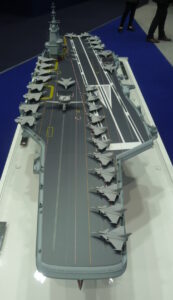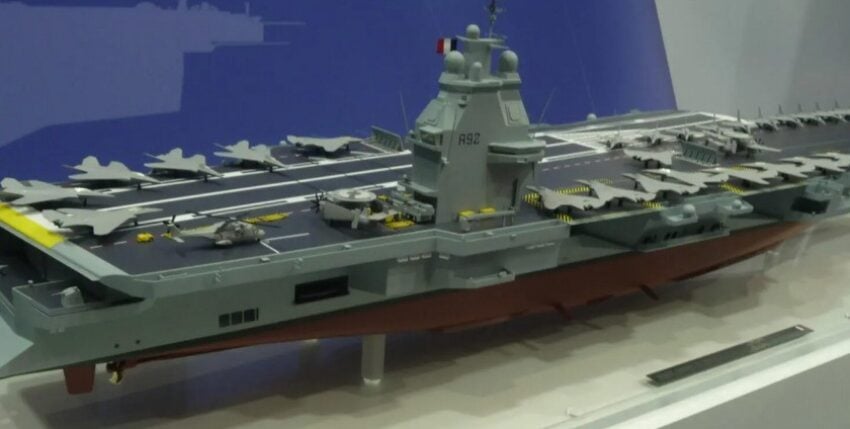The project was launched by the then Minister of Defence Florence Parly at the last live EuroNaval 2018 (only virtual in 2020). Now, on 19 October 2022, the French Ministry of Defence used this year's international naval industry gala at the Naval Group stand in Le Bourget to present a model of the future carrier with some details. The design is not yet finalised insofar as no final decisions have yet been made on the design of the island ('tower' and command bridge of an aircraft carrier) and other elements (such as the number of EMALS). They should be finalised by February 2023 so that the detailed design phase, which follows the French approach, can begin in March 2023. At EuroNaval, there was talk of finalising this work in 2025 with the contract being concluded towards the end of 2025.

Largest European warship
According to previous specifications, the ship will be 310 metres long with a displacement of 75,000 tonnes - compared to only 42,500 tonnes for the "Charles de Gaulle". According to the announcements made during EuroNaval, the future carrier will be able to embark 30 new generation aircraft (six more fighter aircraft than the "Charles de Gaulle" can currently take on board Rafale), two Hawkeye and six helicopters. The crew will amount to 2,000 people. The successor to the "Charles de Gaulle" will be equipped with two or three electromagnetic catapults (EMALS) and new-generation interceptor strings (AAG) supplied by General Atomics. The EMALS have a length of 110 metres (compared to a catapult length of 65 metres on the "Charles de Gaulle"). However, the 'PANG' model presented only has two EMALS.
The nuclear reactor from TechnicAtome is designed to give the carrier ten years of autonomy until the reactor rods are replaced. For the "Charles de Gaulle", this was due every eight years. Around five billion euros have been earmarked in the budget for the aircraft carrier. Earlier estimates put the figure at more than seven billion euros. The carrier is scheduled to enter service in 2038 and remain in service until 2080.
The programme is being carried out by "MO Porte-Avions", a kind of ARGE (consortium) consisting of Naval Group (65%). Chantiers de l'Atlantique (35%) and TechniAtome (for the nuclear part). "This really is a source of great national pride," says Olivier de Saint-Julien, President of MO Porte-Avions. "There are only two countries in the world that can do this: France and the USA."
In other words, the 'PANG' is the largest warship ever built in Europe.

Comparative values for categorisation
The French 'PANG' (Porte-Avions de Nouvelle Génération - New Generation Aircraft Carrier) is 310 metres and 75,000 tonnes in displacement, more than one and a half times the size of its predecessor, the "Charles de Gaulle".
Only the three American carriers of the "Gerald R. Ford" class (333 metres, 100,000 tonnes) and the Chinese newbuilding "Fujian" (318 metres, 100,000 tonnes) are noticeably larger.
Three other types are of roughly the same calibre: slightly larger are the ten US carriers of the "Nimitz" class with a length of 317 metres and a displacement of 97,000 tonnes; slightly smaller is the Type 002 "Shandong", the first aircraft carrier to be built entirely in China, with a length of 315 metres and a displacement of around 70,000 tonnes; the two carriers of the British Royal Navy are even more compact at 283 metres in length and 65,000 tonnes.











4 responses
Congratulations to France.
I realise that a lot of time will pass before the keel is laid and that many changes will probably be made. Not least in terms of costs. But it is remarkable that France is managing this, whereas in Germany, despite having the same budget, there are no funds available for it. If the 2 per cent target is actually implemented, there would probably even be 20 billion euros more available per year than in France.
Thank you very much for your comments. There is actually nothing to add. Except: the two per cent target will not be achieved! But that's a different issue. Personally, I am not necessarily a supporter of the two per cent margin. After all, our defence budget (50+ billion euros!) is extensive. After all, depending on which source you look at - NATO or SIPRI - it is the highest or second highest of the EU states! My view is that we are not using the money properly. How do I come to this conclusion: because I look at what others do with their defence budgets.
Greetings
What should we do with an aircraft carrier? The junk that the British or the French have? Fast submarines or modern frigates make up for it!
Why would Germany need an aircraft carrier? The carriers that the French or British have have no added value. Too few aircraft on board? And which the French now want to build? Let's see if they can cope with it!